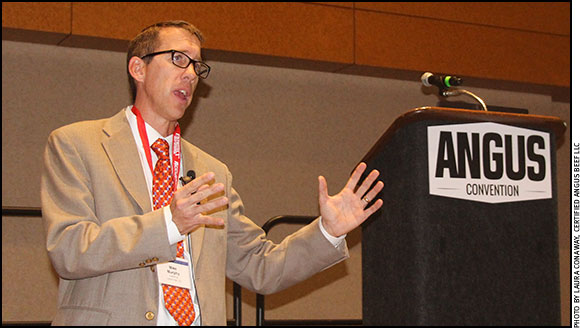
“You can’t just flip the switch on your cow-calf herd. We’re not poultry, and we’re not pork either,” said CattleFax analyst Mike Murphy. “The decision-making process that you go through takes more time.”
‘Stable’ Markets
CattleFax analyst encourages producers during Angus University outlook session.
Dramatic … a wild ride … a roller coaster …
No matter what you’ve called the cattle market in the past few years, you may be glad to hear that the worst is behind you.
“We believe the market is going to stabilize,” said Mike Murphy of CattleFax. “We think the big changes we’ve already incurred in here are going to slow significantly.”
During an Angus University workshop sponsored by Merck Animal Health at the 2016 Angus Convention in Indianapolis, Ind., Nov. 5-7, the longtime analyst said markets may be back on a more predictable track.
“There was a spot in here where the cattle cycle was on sabbatical,” he said. “Mother Nature just never was forgiving enough for our industry to see where we could expand.”
Before widespread drought, modest profits at the cow-calf level should have stimulated cow herd growth.
“We just never could get comfortable with the weather situation, so we weren’t willing to accept that risk even though we had a positive margin,” he said. “All that changed here in 2013. The cattle cycle is back and alive and well.”
As moisture instilled confidence across the country, cattlemen retained heifers and culled fewer mature cows. That led to a short-term shortage of beef, “but at some point that means there’s going to be bigger supply coming to us on the backside. That’s where we are today,” he noted.
Couple that with the “export era” of 2013 and 2014, when stimulus programs around the globe encouraged spending, and today’s worldwide demand for all proteins is lackluster by comparison.
“So we had a record increase of about 3 billion pounds from 2014 to ’15, but then what also happened? Exports declined about a billion pounds in that same time frame,” Murphy said, talking about this “wicked ride” in a “very short period of time.”
In 18 months, fed-cattle prices rose from $119 per hundredweight (cwt.) to as high as $172, and then in two years, they plummeted to $98 per cwt.
Delayed response
“You can’t just flip the switch on your cow-calf herd. We’re not poultry, and we’re not pork either,” he said. “The decision-making process that you go through takes more time.”
January 2016 saw about a million more beef cows than the previous year, and Murphy said he expects 800,000 to 1 million more on Jan. 1, 2017.
“We’ve continued to respond to the economic signals of wanting to continue with our expansion,” Murphy said.
As per capita beef supplies have grown, export growth has not kept pace, “which is, for lack of a better term, dumping more product back here into our domestic market,” he said. “We’ve got to grow exports.”
Pork and poultry are in similar positions, so producers of all three major proteins are nervous as they look toward the yet-to-be-passed Trans-Pacific Partnership (TPP), the analyst noted.
“The importance of that is, it makes us competitive with our competitors,” Murphy said. Without it, these countries may pay 20% less for beef coming from another source, like Australia or Brazil.
Another underlying factor is packing capacity. Based on a 40-hour workweek, beef processors harvest 92,000 head per week, on average. Adding extra weekend labor can move that up to 94,000 head per week. Murphy predicts the high margins will encourage packers to “get more efficiencies out of those plants.”
Pork producers had similar challenges, but look forward to a longer-term fix with more pork plants under construction.
Record-high volatility has also affected beef and other commodities. That’s mainly due to high-frequency trading, where outside investors and computer-generated algorithms can move prices $15 to $18 in a matter of weeks, as it did earlier this fall, he said. Corn is not expected to see significant rallies, however.
Another concern among some cattlemen is the trend in number of cattle sold on arrangements vs. the open market.
Last year there were more fed cattle sold on the spot cash market than the year before, but it’s not “anywhere close” to the same percentage as five years ago, Murphy explained.
CattleFax predicts a trading range of $90 to $120 per cwt. for fed cattle, and $105 to $150 per cwt. on calves in the next few years.
Add value in any market
The market continues to reward cattle that are above average. Those that are vaccinated, weaned, source-verified or likely to meet specifications for high-quality programs like the Certified Angus Beef® (CAB®) brand will bring a premium.
Increasing value across the whole beef business, making the pie bigger for all, is a solid strategy for the future, Murphy said.
“Manage our costs appropriately. Produce that high-quality product. Do the things that you know ultimately the consumer wants for your product, and if we do those things on a consistent basis, then we’re going to be able to stay in business as we go forward,” he said. “It will be a struggle the next few years, but there are some real opportunities out there.”
Those include a stabilized market where “we begin to take the emotion out of the market,” Murphy said, “and start to make decisions driven by the data.”
Murphy’s presentation was one of the Angus University Workshops sponsored by Merck Animal Health Nov. 6 at the 2016 Angus Convention. For additional coverage of the Angus Convention — including summaries, speaker presentations, photos, videos and more — visit the convention newsroom at www.angus.media/news/Angus-Convention.
Editor’s Note: Miranda Reiman is assistant director of industry information for Certified Angus Beef LLC.







